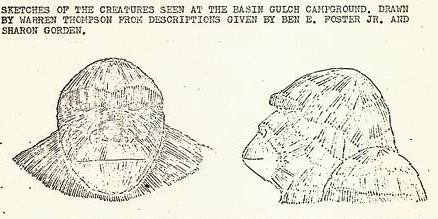
Above is the late Warren Thompson‘s drawings of the Bigfoot seen during the encounters that took place during the Basin Gulch Expedition of the Bay Area Group. The individuals involved (Ben E. Foster, Jr., Sharon Gorden, and Richard Foster), who Thompson had guide his sketching, reported seeing several Bigfoot the night of August 11, 1970.

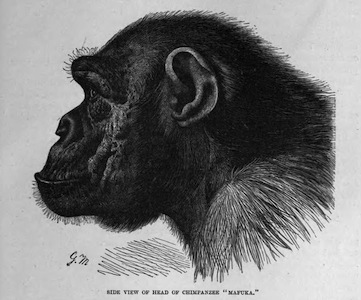

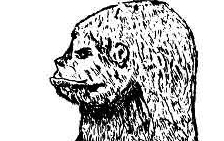
Everyone knows the name Jim McClarin who began his Bigfoot investigations in 1963, going on early expeditions from northern California to Alaska. McClarin is famous for carving the very first Bigfoot statue (located at the corner of Highways 96 & 299 in Willow Creek, California).
Jim early explained that he put a browridge on his Willow Creek Bigfoot because he was following Ivan T. Sanderson, specifically this drawing.
This is the field-sketch of the head of a female Sasquatch by Ivan T. Sanderson, drawn under the firsthand direction of Albert Ostman. This was misidentified as a “male Sasquatch” originally in Sanderson’s Abominable Snowmen: Legend Come to Life, 1961.
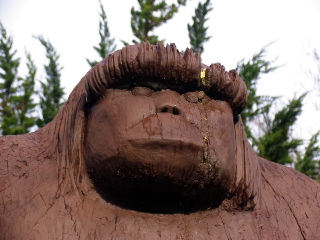
The curly description by Albert Ostman, from his 1924 sighting, was the inspiration for Ivan Sanderson’s drawing, and thus of Jim McClarin/Willow Creek Bigfoot statue’s browridge (above). The brow of the Albert Ostman Old Woman Sasquatch is shown in this 1966 drawing by Roger Patterson (below, on left), compared with the Bluff Creek Bigfoot filmed at Bluff Creek in 1967.

Jim McClarin’s Willow Creek Bigfoot Statue. Photograph by Tom Yamarone, with used with permission.
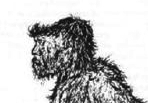

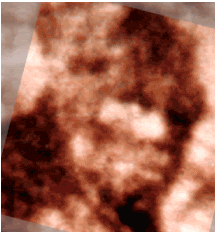
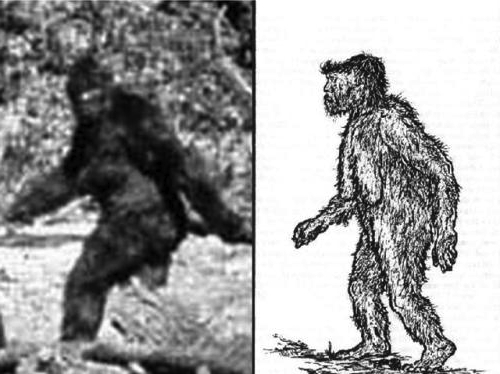
In the past discussions on Bigfoot, few have noticed the disappearance of the prognathism. The head and nose changed too, and the entire profile of the face changes with the vanishing of the projected lower facial features.
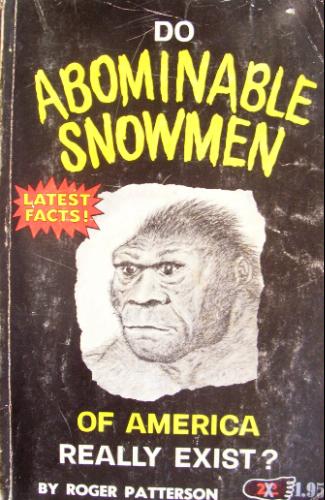
Patterson noted that one of the first articles that got him into the hunt for Bigfoot was by Ivan T. Sanderson. The cover art on that article shows the William Roe case, illustrated by Mort Künstler. Roger Patterson copied the art closely and then published Sanderson’s entire article in Patterson’s book. Many have commented on how the Künstler-Patterson art mirrors the P-G film Bigfoot.
I think the key is the changed face.
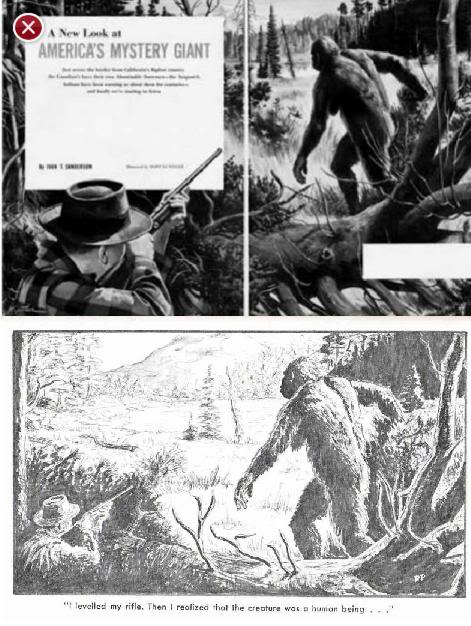
This trend in Bigfoot/Sasquatch faces, I’m afraid, continues in the direction of humanizing them. One of the extreme examples of this is the facial profiles by the skilled forensic artist Harvey Pratt. My critique of Pratt’s drawings are that they all look “beautiful” to readers, but they also seem to all look exactly alike – with subtle differences, but very human and looking like human criminals with more hair.
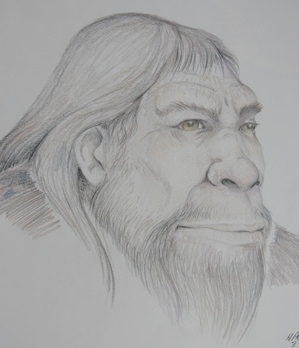
Art by Harvey Pratt (Source: C2C)
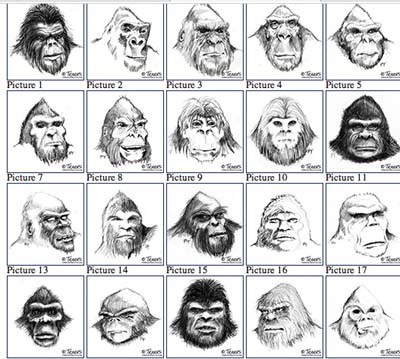
Pete Travers’ Bigfoot/Sasquatch Sketch Project
Is there a difference been the drawings made by the older out-in-the-field fieldworkers, directed by actual eyewitnesses? Do the early ones appear to look more like apes than those made by
chroniclers and others trying to capture Bigfoot’s appearance from the written word? Does the mixing of recent artists’ own strong personal styles and bias make Bigfoot of today look more “human”?
Food for thought.

And yet the Thompson’s drawings are more recent than the P-G film.
Yes, RPJ, exactly. But the source of WT’s drawings were not reconstructions. They were not evolved cultural imagery. They were done from direct eyewitnesses being interviewed and under their direction. The P-G threshold is a branch in the road, not a waterfall event.
My limited understanding is that the variance in depiction may lie in the theoretical versus the actual. The real difference as I see it is in the nose. Actual witnesses consistently report a “hooded” or more humanlike nose, while the theorists, e.g., the giganto crowd, show a more simian nose. For my two cents, if Bigfoot exists, it is clearly bipedal a trait which predates modern great apes, and as such most likely would have evolved on a similar path as humans, making a hooded nose more likely.
Loren, can you clarify something for me? I’ve never seen the sketch by Patterson- he drew it before the P-G film? If so, that’s remarkable, don’t you think? Excellent post, thanks!
mandors: That is interesting about the dichotomy on what’s-the-nose-like. I remember telling John Bindernagel at the 2009 Texas Bigfoot Conference about the hooded nose being a prominent feature of many reports; he expressed surprise. I’d bet personally based on my read that when I see one, it won’t have a nose like a gorilla.
PoeticsOfBigfoot: Not sure how “remarkable” the Patterson drawing is. To me it looks much more like Elvis than it does like Patty. I definitely would expect that drawing to come from before his seeing what one actually looked like.
I should have noted:
Look at Robert Bateman’s (prominent wildlife artist, from Canada) painting of a sasquatch.
http://proxy.baremetal.com/artcountrycanada.com/images/bateman-sasquatch-cropped.jpg
Looks like he got his nose take from Bindernagel, another Canadian, and their Jeff Meldrum, really, so no surprise there.
What the heck. Here’s Bateman’s yeti:
http://www.sasquatchresearch.net/images/yetibateman.jpg
Another gorillanose.
Loren looking at Patty again it finally dawned on me who she reminded me of.
Biffa Bacon in The Viz
http://www.guardian.co.uk/culture/cartoon/2009/nov/07/1
And Bully Beef out The Dandy
http://bigrab.wordpress.com/tag/bully-beef-and-chips/
And if Biffa and Bully’s mums don’t clue you in Patty’s relatives still dwell in Britain how’s about this for living proof Patty actually hails from Liverpool!
http://www.toontastic.net/board/topic/24167-i-didnt-know-that-biffa-bacons-mother-supported-liverpool/
Elvis? You’re kidding, right? I’d like to know what Loren thinks.
poeticsofbigfoot: oh, I’d like to know what Loren thinks too, but for my money, if you are gonna make a suit, make one that looks like your drawing. That would have been easy. But Patterson demonstrably didn’t.
Here are two interesting reports in their description of the subject, particularly the face.
http://bfro.net/GDB/show_report.asp?id=39268
http://woodape.org/reports/report/detail/429
Several things worth noting here:
1) We have an inherent bias in these matters. Anything that looks remotely human is going to register big time and shift the naive observer’s take toward “human.” Shoot, Bobbie Short has them down as human based on the footprints.
2) When I first saw a close-up of an orangutan’s face, as a small child, my reaction was: THAT’S A PERSON!
3) When National Geographic put the A. afarensis baby on its cover with the headline “First Child”, I thought: that’s an orangutan.
4) Artists only have the witness’s description to go on. That leaves a lot of room for error.
The face doesn’t make it any more human than bipedalism (birds) and footprints do.